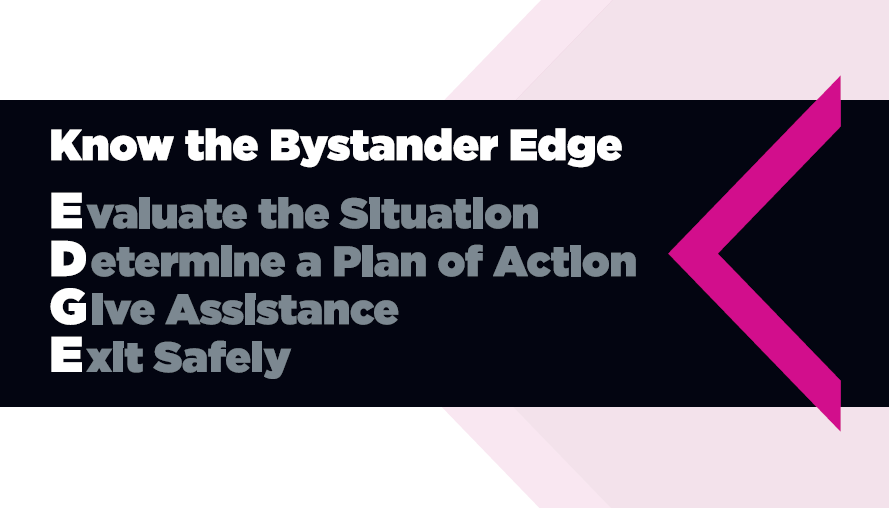
University Definitions
Definitions are provided to ensure that all members of the university community have a shared understanding of the kinds of behaviors that may constitute violations of the policy. It is important to note that the university policy includes prohibition of behaviors that may also constitute violations of the state and federal law. While it is not the role of the university to determine whether a crime occurred or a was violated, the university still has obligations under Title IX to address those behaviors that may constitute a violation of the policy.
The university encourages students, faculty and staff, and others in the university community to review such terms so as to educate themselves on what constitutes sexual misconduct and how we, as a community, can eliminate such acts from happening. As discussed in the policy coverage section, the university uses the term sexual misconduct in this policy as an umbrella term to include intimate relationship (including dating and domestic) violence, sex-based discrimination, sex-based intimidation, sex-based retaliation, sexual assault (including acquaintance rape), sexual exploitation, and sexual harassment. Individuals should also review the definitions of criminal behaviors as they appear in the Florida Statutes and other applicable jurisdictions.1
University Definitions
Consent:
Informed, voluntary, and mutual agreement to engage in a sexual activity. Consent must be sought by the initiator of each act, and can be withdrawn at any time. There is no consent when there is force, expressed or implied, or when coercion, intimidation, threats, or duress is used. Whether a person has taken advantage of a position of influence over another person may be a factor in determining consent. Silence or absence of resistance does not imply consent. Past consent to sexual activity with another person does not imply ongoing future consent with that person or consent to that same sexual activity with another person.
If a person is mentally or physically incapacitated or impaired so that such person cannot understand the fact, nature, or extent of the sexual situation, there is no consent; this includes impairment or incapacitation due to alcohol or drug consumption that meets this standard, being asleep or unconscious, or being under the legal age to give consent.
 |
| Can I Have Your Pen? |
Intimate Relationship Violence:
Violence or the threat of violence between those in a sexual and/or comparably personal and private relationships. Violence may be sexual in nature (such as sexual assault), or it may be physical violence such as making death threats, punching, kicking, or using a weapon. The existence of such a relationship shall be determined based on the reporting party’s statement and with consideration of the length of the relationship, the type of relationship, and the frequency of interaction between the person involved in the relationship. This includes the following criminal behaviors:
Dating Violence:
Violence, including sexual or physical violence or the threat of such violence, committed by a person who is or has been in a social relationship of a romantic or intimate nature with the victim.
Domestic Violence:
A felony or misdemeanor crime of violence committed—
- By a current or former spouse or intimate partner of the victim;
- By a person with whom the victim shares a child in common;
- By a person who is cohabitating with or has cohabitated with the victim as a spouse or intimate partner;
- By a person similarly situated to a spouse of the victim under the domestic or family violence laws of the jurisdiction in which the crime of violence occurred.
Hostile Environment:
Exists when sex-based harassment is sufficiently serious to deny or limit a person’s ability to participate in or benefit from the university’s programs or activities.
A hostile environment can be created by anyone involved in a university’s program or activity (e.g., administrators, faculty members, students, and campus visitors).
In determining whether sex-based harassment has created a hostile environment, the university considers the conduct in question from both a subjective and objective perspective. It will be necessary, but not enough, that the conduct was unwelcome to the person who was harassed. But the university will also need to find that a reasonable person in the person’s position would have perceived the conduct as undesirable or offensive in order for that conduct to create or contribute to a hostile environment.
To make the ultimate determination of whether a hostile environment exists for a person or persons, the university considers a variety of factors related to the severity, persistence, or pervasiveness of the sex-based harassment, including: (1) the type, frequency, and duration of the conduct; (2) the identity and relationships of persons involved; (3) the number of individuals involved; (4) the location of the conduct and the context in which it occurred; and (5) the degree to which the conduct affected one or more student’s education.
The more severe the sex-based harassment, the less need there is to show a repetitive series of incidents to find a hostile environment. Indeed, a single instance of sexual assault may be sufficient to create a hostile environment. Likewise, a series of incidents may be sufficient even if the sex-based harassment is not particularly severe.
Retaliation:
An action taken by an accused individual or an action taken by a third party against any person because that person has opposed any practices forbidden under this policy or because that person has filed a complaint, testified, assisted, or participated in any manner in an investigation or proceeding under this policy. This includes action taken against a bystander who intervened to stop or attempt to stop discrimination, harassment, or sexual misconduct. Retaliation includes intimidating, threatening, coercing, or in any way discriminating against an individual because of the individual’s complaint or participation. Action is generally deemed retaliatory if it would deter a reasonable person in the same circumstances from opposing practices prohibited by this policy.
Sexual Assault:
Actual or attempted sexual contact with another person without that person’s consent. Sexual assault includes, but is not limited to:
- Intentional touching of another person’s intimate parts without that person’s consent; or
- Other intentional sexual contact with another person without that person’s consent; or
- Coercing, forcing, or attempting to coerce or force a person to touch another person’s intimate parts without that person’s consent; or
- Rape, which is penetration, no matter how slight, of (1) the vagina or anus of a person by any body part of another person or by an object, or (2) the mouth of a person by a sex organ of another person, without that person’s consent.
- Includes acquaintance rape, which is defined as forced, manipulated, or coerced sexual intercourse by a friend or acquaintance.
Sexual Exploitation:
Occurs when a person takes sexual advantage of another person for the benefit of anyone other than that person without that person’s consent. Examples of behavior that could rise to the level of sexual exploitation include:
- Prostituting another person;
- Recording images (e.g., video, photograph) or audio of another person’s sexual activity, intimate body parts, or nakedness without that person’s consent;
- Distributing images (e.g., video, photograph) or audio of another person’s sexual activity, intimate body parts, or nakedness, if the individual distributing the images or audio knows or should have known that the person depicted in the images or audio did not consent to such disclosure and objects to such disclosure; and
- Viewing another person’s sexual activity, intimate body parts, or nakedness in a place where that person would have a reasonable expectation of privacy, without that person’s consent, and for the purpose of arousing or gratifying sexual desire.
Sexual Violence
Physical sexual acts perpetrated against a person’s will or where a person is incapable of giving consent. Sexual violence includes rape, sexual assault, sexual battery, sexual abuse, and sexual coercion. Depending on the specific conduct, stalking may also be considered a form of sexual violence.
Sex-Based Harassment:
Unwelcome conduct based on actual or perceived sex or gender, which includes:
Gender-Based Harassment:
Unwelcome conduct of a nonsexual nature based on a person’s actual or perceived gender, sexual orientation, gender identity, gender expression, or nonconformity with gender stereotypes.
Sexual Harassment:
Unwelcome conduct of a sexual nature. Examples include: unwelcome sexual advances; requests for sexual favors; or other verbal or nonverbal conduct of a sexual nature, including rape, sexual assault, and sexual exploitation. In addition, depending on the facts, dating violence, domestic violence, and stalking may also be forms of sexual harassment.
Another form of sexual harassment is "quid pro quo" harassment. This occurs when unwelcome sexual advances and/or requests for sexual favors are made by a person with power or authority over another when submission to such conduct is used as the basis for, or is implicitly or explicitly a term or condition of, employment and/or academic decision(s) or evaluation(s). An example of this type of sexual harassment is if a faculty member or supervisor offers to provide a positive reference letter in exchange for sexual favor(s) from a student.
Stalking:
- Engaging in a course of conduct directed at a specific person that would cause a reasonable person to—
- Fear for the person’s safety or the safety of others; or
- Suffer substantial emotional distress.
- For the purpose of this definition—
- Course of conduct means two or more acts, including but not limited to, acts in which the stalker directly, indirectly, or through third parties, by any action, method, device, or means follows, monitors, observes, surveils, threatens, or communicates to or about, a person, or interferes with a person’s property.
- Substantial emotional distress means significant mental suffering or anguish that may, but does not necessarily, require medical or other professional treatment or counseling.
- Reasonable person means a reasonable person under similar circumstances and with similar identities to the victim.
Unwelcome Conduct:
Conduct is considered “unwelcome” if the person did not request or invite it and considered the conduct to be undesirable or offensive.
Unwelcome conduct may take various forms, including, name-calling, graphic or written statements (including the use of cell phones or the Internet), or other conduct that may be physically threatening, harmful, or humiliating. Unwelcome conduct does not have to include intent to harm, be directed at a specific target, or involve repeated incidents. Unwelcome conduct can involve persons of the same or different sexes.
Participation in the conduct or the failure to complain does not always mean that the conduct was welcome. The fact that a person may have welcomed some conduct does not necessarily mean that a person welcomed other conduct. Also, the fact that a person requested or invited conduct on one occasion does not mean that the conduct is welcome on a subsequent occasion.
Foot note: 1. This policy does not impair the freedom of expression in one’s speech, except to prohibit sex-based harassment that creates a hostile environment. In this and other ways, the university applies and enforces this policy in a manner that respects the freedom of expression of students, faculty, and others.